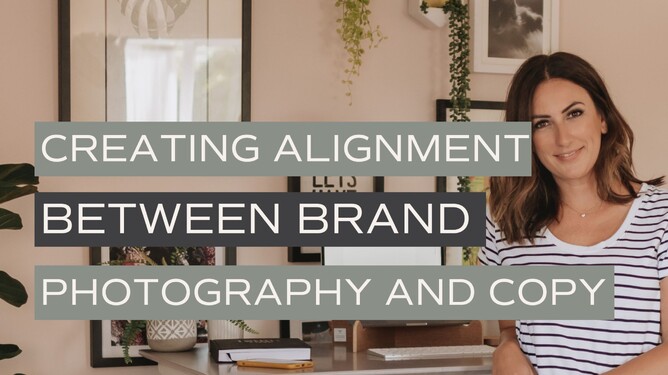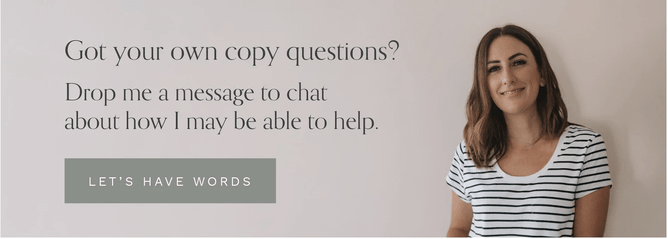Our brains are primed to process visual information with incredible efficiency. In fact, we can process images 60,000 times faster than text, and 90% of the information our brain consumes is visual.
And as much as it pains me, I have to concede that around 80% of the copy on most web pages doesn’t even get read. And of what we do read, only 20% is processed.
[Can you hear that? That’s the sound of copywriter hearts breaking at the thought of our pored-over subhead not getting the recognition it deserves.]
So, yes, that leaves a measly amount of copy that is actually remembered by your website visitors—which is why you really need to make words count.
More importantly, for your words to have their best impact, they need to align with the visual story you’re telling, too.
Brand photography has become an essential tool in creating a strong and memorable identity. But it’s more than just images on a website or social media feed—it’s a powerful communication tool that tells your brand’s story in ways words alone cannot.
The role of brand photography
At its core, brand photography gives your business a tangible presence. It offers customers a glimpse into who you are, what you do, and what kind of vibe you offer. Whether it's product photography, lifestyle shots, or portraits of your team, these images tell a story that resonates with your target audience by evoking emotions, building trust, and humanising your brand. Great visuals set the tone and convey the personality of your business, making the intangible elements of your brand—like values and essence—visible.
But lovely photography alone isn’t enough. To fully engage your audience, your copy needs to reflect and enhance the message conveyed by the visuals. This synergy between visuals and text is what creates a seamless, cohesive brand experience.
Why copy needs to align with visuals
Imagine landing on a website that features sleek, minimalist design, but the copy is playful, overly casual, and filled with quirky phrases. The disconnect between what you see and what you read can be jarring and confusing. The same applies in reverse. Strong visuals accompanied by disjointed, inconsistent copy can dilute your message, making it hard for your audience to trust or even understand your brand.
This article was inspired by a client who had stunning, serene, almost ethereal images of where her business is located. They offered a sense of space and peacefulness and calm.
But the copy didn’t fit. It was cluttered and chunky; lots of filler words and repetition. There was misalignment between what these dreamy images were telling me vs the overwhelm (and underwhelm) of the chaotic copy.
The role of copy is to provide the context that visuals alone can't. It adds depth and dimension to your brand’s story, explaining the who, what, and why behind the visuals. When done right, copy amplifies the underlying message already being communicated through photography, ensuring your audience feels the connection between what they see and what they read.
It’s not just about the words you use, but also how you use them
The structure of your sentences creates pace and rhythm, which can shift the mood of your writing.
Having visuals (photography) to immerse yourself in can help guide the kind of emotion you want to create in your copy.
Do you want your readers to feel energised? Or do you want them to feel like they have the space to take in more meaningful thoughts? Perhaps you want to create a feeling of immediacy (short sentences) or sentimentality (long sentences). If you’re aiming for a more conversational tone, brackets can take your reader on a brief detour from the main idea, and create a sense of free flowing thought.
Most readers won’t be consciously aware of the rhythm of your writing - and that’s the point. You want the focus to still remain on the words you use, but consider the hierarchy of your message. Which points need to be communicated with emphasis and drama? And which points need to encourage your reader to settle into a feeling? And what feeling do you want that to be for them?
Create balance with the amount of copy you use. If you’re trying to reflect lightness and spaciousness, large chunks of text are not going to work. Avoid complex language and filler words
How to get the visual and copy alignment right
Clarify your brand story and voice
To ensure your copy and visuals work harmoniously, you need to go back to brand basics first. Start by defining your brand's core values, personality, and tone of voice. Are you playful and quirky, or serious and professional? Understanding this will help both your photographer and copywriter craft content that complements your brand’s essence. The visuals should set the mood, and the copy should reinforce it.Collaborate early in the process
Rather than treating photography and copywriting as separate processes, bring your photographer and copywriter together from the start. When both teams understand the goals of the campaign or project, they can work in tandem to ensure the visual storytelling and written content align seamlessly.Use photography to inspire the copy
Sometimes, visuals can provide the spark for the perfect copy. A well-composed image of your product or service in action can inspire descriptive, emotive copy that enhances the experience. The energy and mood captured in the photos can serve as a guide for the language and tone of your copy.Keep consistency across platforms
Whether it's a website, social media, or email marketing, your visuals and copy should carry the same message across all touchpoints. Consistency creates familiarity and trust with your audience.Test and iterate
If something feels off, don’t hesitate to refine either the copy or visuals to improve alignment. Continuous refinement helps you stay responsive to audience preferences while maintaining your brand’s integrity.
Professional brand photography is more than just an aesthetic choice; it’s a critical part of how your brand communicates and connects with your audience. But to make a lasting impression, those visuals need to be paired with carefully crafted copy that enhances the story your photos are telling. When your photography and copy align, the result is a cohesive brand experience that resonates with your audience and tells a more memorable story.
The key takeaway? Invest in both great photography and great copywriting—because when they work together, they can make all the difference to how your brand is perceived.


